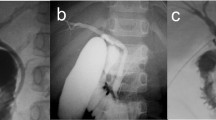Abstract
Introduction
Pancreaticobiliary maljunction (PBM) is a congenital anomaly, which can be defined as a union of the pancreatic and biliary ducts located outside off the duodenal wall. We herein investigate clinical features of PBM including as the 2nd report of a Japanese nationwide survey.
Patients and methods
During a period of 18 years (from 1990 to 2007), 2,561 patients with PBM were registered at 141 medical institutions in Japan. Among them, eligible patients (n = 2,529) were divided into two groups: adult (n = 1,511) and pediatric patients (n = 1,018). Comparisons of clinical features including associated biliary cancers were performed according to the biliary dilatation (BD), age factor, and time era.
Results
Only one case in pediatric patients with BD combined with a bile duct cancer (0.1 %). In adult patients, the bile duct cancer and the gallbladder cancer was seen in 6.9 and 13.4 % patients with BD and in 3.1 and 37.4 % patients without BD, respectively. In adult patients with BD, the occurrence rates of biliary cancers were increased in latter period (00’–07’) compared with former period (90’–99’). The ratio of biliary cancer localization was changed between former and latter period, and the bile duct cancer was increased in latter period (from 5.5 to 9.3 %).
Conclusions
The largest series of PBM were evaluated to clarify the clinical features including the associated biliary cancer in this Japan-nationwide survey. This report could be widely used in the future as a reference data for diagnosis and treatment of PBM.








Similar content being viewed by others
Abbreviations
- PBM:
-
Pancreaticobiliary maljunction
- JSPBM:
-
The Japanese Study Group on Pancreaticobiliary Maljunction
- BD:
-
Biliary dilatation
- CI:
-
Confidence interval
References
Kozumi K, Kodama T. A case of cystic dilatation of the common bile duct and etiology of the disease (in Japanese). Tokyo Med J. 1916;30:1413–23.
Babbitt DP. Congenital choledochal cysts: new etiological concept based on anomalous relationships of the common bile duct and pancreatic bulb. Ann Surg. 1969;12:231–40.
Komi N, Kuwashima T, Kuramoto M, Udaka H, Ogasahara K. Anomalous arrangement of the pancreaticobiliary ductal system in choledochal cyst. Tokushima J Exp Med. 1976;23:37–48.
The Japanese Study Group on Pancreaticobiliary Maljunction (JSPBM), The Committee of JSPBM for Diagnostic Criteria. Diagnostic criteria of pancreaticobiliary maljunction. J Hepatobiliary Pancreat Surg. 1994;1:219–21.
Tashiro S, Imaizumi T, Ohkawa H, Okada A, Katoh T, Kawaharada Y, et al. Pancreaticobiliary maljunction: retrospective and nationwide survey in Japan. J Hepatobiliary Pancreat Surg. 2003;10:345–51.
Kamisawa T, Ando H, Suyama M, Shimada M, Morine Y, Shimada H. Japanese clinical practice guidelines for pancreaticobiliary maljunction. J Gastroenterol. 2012;47:731–59.
Funabiki T. Pancreaticobiliary maljunction—focused on biliary carcinogenesis (in Japanese). Jpn J Gastroenterol Surg. 2000;33:261–70.
Matsubara T, Sakurai Y, Sasayama Y, Hori H, Ochiai M, Funabiki T, et al. K-ras point mutations in cancerous and noncancerous biliary epithelium in patients with pancreaticobiliary maljunction. Cancer. 1996;77:1752–7.
Matsubara T, Sakurai Y, Zhi LZ, Miura H, Ochiai M, Funabiki T. K-ras and p-53 gene mutations in noncancerous biliary lesions of patients with pancreaticobiliary maljunction. J Hepatobiliary Pancreat Surg. 2002;9:312–21.
Hanada K, Itoh M, Fujii K, Tsuchida A, Hirata M, Ishimaru S, et al. Pathology and cellular kinetics of gallbladder with an anomalous junction of pancreaticobiliary duct. Am J Gastroenterol. 1996;91:1007–11.
Nagai M, Watanabe M, Iwase T, Yamao K, Isaji S. Clinical and genetic analysis of noncancerous and cancerous biliary epithelium in patients with pancreaticobiliary maljunction. World J Surg. 2002;26:91–8.
Matsuda T, Marugame T, Kamo K, Katanoda K, Ajiki W, Sobue T, The Japan Cancer Surveillance Research Group. Cancer incidence and incidence rates in Japan in 2003: based on data from 13 population-based cancer registries in the monitoring of cancer incidence in Japan (MCIJ) project. Jpn J Clin Oncol. 2009;39:850–8.
Miyazaki M, Takada T, Miyakawa S, Tsukada K, Nagino M, Kondo S, et al. Risk factors for biliary tract and ampullary carcinomas and prophylactic surgery for these factors. J Hepatobiliary Pancreat Surg. 2008;15:15–24.
Ichikawa Y, Kamiyama M, Sekido H, Ishikawa T, Miura Y, Kamiya N, et al. Telomerase activity and Bcl-2 expression in gallbladders of pancreaticobiliary maljunction patients: a preliminary study. J Hepatobiliary Pancreat Surg. 2004;11:34–9.
Conflict of interest
The authors have no conflict of interest to declare regarding the contents of this manuscript.
Author information
Authors and Affiliations
Corresponding author
About this article
Cite this article
Morine, Y., Shimada, M., Takamatsu, H. et al. Clinical features of pancreaticobiliary maljunction: update analysis of 2nd Japan-nationwide survey. J Hepatobiliary Pancreat Sci 20, 472–480 (2013). https://doi.org/10.1007/s00534-013-0606-2
Published:
Issue Date:
DOI: https://doi.org/10.1007/s00534-013-0606-2




